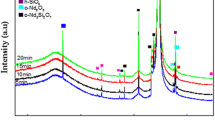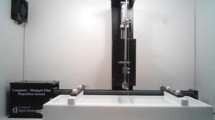Abstract
The results of a comprehensive study of the structural-morphological and thermodynamic characteristics of the electrochemical precipitation of Cu in transition holes with a barrier layer of TiN in Si/SiO2 substrates by scanning electron microscopy (SEM) and differential thermal analysis (DTA) are presented. The temperature range that determines the heat resistance of copper (up to 750°C) and the temperature range (up to 886°C) that determines the thermal stability of the composite as a whole, as well as the ability to maintain the chemical composition and ordered structure at elevated temperatures, are found.






Similar content being viewed by others

Notes
RTT was carried out in two stages: first at a temperature of 650°C for 30 s, then at 850°C for 30 s.
REFERENCES
Cheng, Yi.-L., Lee, Ch.-Ye., and Huang, Ya.-L., Noble and precious metals—properties, nanoscale effects and applications, in Copper Metal for Semiconductor Interconnects, Rijeka: IntechOpen, 2018, Chap. 10. https://doi.org/10.5772/intechopen.69142
Wolf, M.J., Dretschkow, T., Wunderle, B., et al., High aspect ratio TSV copper filling with different seed layers, in Proceedings of the ECTC: Electronic Components and Technology Conference, May 27–30, 2008, Lake Buena Vista, FL: IEEE, 2008, pp. 563–570.
Radisic, A., Luhn, O., Philipsen, H.G.G., et al., Copper plating for 3D interconnects, Microelectron. Eng., 2011, vol. 88, pp. 701–704. https://doi.org/10.1016/j.mee.2010.06.030
Electroless Plating: Fundamentals and Applications, Mallory, G.O. and Hajdu, J.B., Orlando: Am. Electroplaters Surf. Finishers Soc., 1990.
Toimil-Molares, M.E., Buschmann, V., Dobrev, D., et al., Single-crystalline copper nanowires produced by electrochemical deposition in polymeric ion track membranes, Adv. Mater., 2001, vol. 13, pp. 62–65. https://doi.org/10.1002/chin.200118218
Edelstein, D., Heidenreich, J., Goldblatt, R., et al., Full copper wiring in a sub-0.25 μm CMOS ULSI technology, in Proceedings of the IEEE International Electron Device Meeting, New York: IEEE, 1997, pp. 773–776.
Edelstein, D.C., Sai-Halasz, G.A., and Mii, Y.J., LSL on-chip interconnection performance simulations and measurements, IBM J. Res. Dev., 1995, vol. 39, pp. 383–401. https://doi.org/10.1147/rd.394.0383
Song, C., Wang, Z., Chen, Q., et al., High aspect ratio copper through-silicon-vias for 3D integration, Microelectron. Eng., 2008, vol. 85, pp. 1952–1956. https://doi.org/10.1016/j.mee.2008.05.017
Radisic, A., Cao, Y., Taephaisitphongse, P., et al., Direct copper electrodeposition on tan barrier layers, J. Electrochem. Soc., 2003, vol. 150, no. 5, pp. C362–C367. https://doi.org/10.1149/1.1565137
Moffat, T.P., Walker, M., Chen, P.J., et al., Electrodeposition of Cu on Ru barrier layers for damascene processing, J. Electrochem. Soc., 2006, vol. 153, no. 1, pp. C37–C50. https://doi.org/10.1149/1.2131826
Park, K.-S. and Kim, S., Seedless copper electrodeposition onto tungsten diffusion barrier, J. Electrochem. Soc., 2010, vol. 157, pp. D609–D613. https://doi.org/10.1149/1.3491351
Mei, Q.S. and Lu, K., Melting and superheating of crystalline solids: from bulk to nanocrystals, Prog. Mater. Sci., 2007, no. 52, pp. 1175–1262. https://doi.org/10.1016/j.pmatsci.2007.01.001
Shilyaeva, Yu.I., Bardushkin, V.V., Gavrilov, S.A., et al., Melting temperature of metal polycrystalline nanowires electrochemically deposited into the pores of anodic aluminum oxide, Phys. Chem. Chem. Phys., 2014, vol. 16, pp. 19394–19401. https://doi.org/10.1039/C4CP02436B
Shilyaeva, Yu., Gavrilov, S., Dudin, A., et al., Anodic aluminium oxide templates for synthesis and study of thermal behaviour of metallic nanowires, Surf. Interface Anal., 2015. https://doi.org/10.1002/sia.5892
Andrievskii, R.A., Nanomaterials: Concept and modern problems, Ross. Khim. Zh., 2002, vol. 46, no. 5, pp. 50–56.
Huber, T., Degischer, H.P., Lefranc, G., et al., Thermal expansion studies on aluminium-matrix composites with different reinforcement architecture of SiC particles, Compos. Sci. Technol., 2006, vol. 66, pp. 2206–2217. https://doi.org/10.1016/j.compscitech.2005.12.012
Wendlandt, W.W., Thermal Methods of Analysis, New York: Wiley, 1974.
Turtsevich, A.S., Kolos, V.V., Adashkevich, S.V.B., et al., Method for forming a titanium disilicide film on a silicon substrate, BY Patent No. 16839 C1, 2013.
Vorobjova, A.I., Labunov, V.A., Utkina, E.A., and Grapov, D.V., Metallization of vias in silicon wafers to produce three-dimensional microstructures, Russ. Microelectron., 2021, vol. 50, no. 1, pp. 8–18. https://doi.org/10.1134/S1063739721010108
Mikolajunas, M., Kaliasasa, R., Andruleviciusb, M., et al., A study of stacked PECVD silicon nitride films used for surface micromachined membranes, Thin Solid Films, 2008, vol. 516, no. 23, pp. 8788–8792. https://doi.org/10.1016/j.tsf.2008.06.063
Shiliang Wang, Xiaolin Huang, Yuehui He, et al., Synthesis, growth mechanism and thermal stability of copper nanoparticles encapsulated by multi-layer graphene, Carbon, 2012, vol. 2, pp. 21–25. https://doi.org/10.1016/j.carbon.2011.12.063
Ponder, S.M., Darab, J.G., Bucher, J., Caulder, D., Craig, I., Davis, L., et al., Surface chemistry and electrochemistry of supported zerovalent iron nanoparticles in the remediation of aqueous metal contaminants, Chem. Mater., 2001, vol. 13, no. 2, pp. 479–486. https://doi.org/10.1021/cm000288r
Liu, X.M. and Zhou, Y.C., Electrochemical synthesis and room temperature oxidation behavior of Cu nanowires, J. Mater. Res., 2005, vol. 20, no. 9, pp. 2371–2378. https://doi.org/10.1557/jmr.2005.0288
Yao Zhi Hu, Sharangpani, R., and Tay, S.-P., In situ rapid thermal oxidation and reduction of copper thin films and their applications in ultralarge scale integration, J. Electrochem. Soc., 2001, vol. 148, no. 12, pp. G669–G675. https://doi.org/10.1149/1.1413480
Li, J., Shacham-Diamand, Y., and Mayer, J.W., Copper deposition and thermal stability issues in copper-based metallization for ULSI technology, MRS Bull., 1993, vol. 98, no. 6, pp. 18–21. https://doi.org/10.1016/0920-2307(92)90011-O
Benito, N. and Flores, M., Evidence of mixed oxide formation on the Cu/SiO2 interface, J. Phys. Chem. C, 2017, vol. 121, pp. 18771–18778. https://doi.org/10.1021/acs.jpcc.7b06563
Gorelik, S.S., Rekristallizatsiya metallov i splavov (Recrystallization of Metals and Alloys), Moscow: MISIS, 2005.
Haessner, F., Recrystallization of Metallic Materials, Stuttgart: Max-Plank Inst. Metallforsch., 1971.
Okada, T., Tai, H., and Tagami, M., Early-stage recrystallized grains in copper single crystals deformed in tension along 〈111〉 direction, Mater. Trans., 2017, vol. 58, no. 4, pp. 574–579. https://doi.org/10.2320/matertrans.M2016455
Vasiliev, A.G., Orlikovsky, A.A., Rodatis, V.V., and Horin, I.A., Contact TiSi2 and barrier TiN layers for ULSI multilevel metallization, Russ. Microelectron., 2002, vol. 31, no. 1, pp. 7–12.
Chen, C.H., Yamaguchi, T., Sugawara, K.I., and Koga, K., Role of stress in the self-limiting oxidation of copper nanoparticles, J. Phys. Chem. B, 2005, vol. 109, no. 44, pp. 20669–20672. https://doi.org/10.1021/jp0546498
Anishchik, V.M., Gorushko, V.A., Pilipenko, V.A., et al., Fizicheskie osnovy bystroi termoobrabotki i oborudovanie. Sozdanie mnogourovnevoi metallizatsii (Physical Basis of Rapid Heat Treatment and Equipment. Creating Multilevel Plating), Minsk: Bel. Gos. Univ., 2000.
Murarka, Sh.P., Silicides for VLSI Applications, New York: Academic, 1983.
Gromov, D.G., Gavrilov, S.A., Redichev, E.N., and Ammosov, R.M., Kinetics of the melting-dispersion process in copper thin films, Phys. Solid State, 2007, vol. 49, no. 1, pp. 178–184.
Geguzin, Ya.E., Fizika spekaniya (Physics of Sintering), Moscow: Nauka, 1984.
Mei, Q.S. and Lu, K., Melting and superheating of crystalline solids: From bulk to nanocrystals, Prog. Mater. Sci., 2007, no. 52, pp. 1175–1262. https://doi.org/10.1016/j.pmatsci.2007.01.001
Liu, X., Chen, Q., Dixit, P., Chatterjee, R., et al., Failure mechanisms and optimum design for electroplated copper through-silicon vias (TSV), in Proceedings of the IEEE 2009 Electronic Components and Technology Conference, 2009, pp. 624–629.
Kikoin, I.K., Tablitsy fizicheskikh velichin. Spravochnik (Tables of Physical Values, Reference Book), Moscow: Atomizdat, 1976.
Ramm, P., Wolf, M.J., Klumpp, A., Wieland, R., et al., Through silicon via technology—processes and reliability for wafer-level 3D system integration, in Proceedings of the 2008 IEEE Electronic Components and Technology Conference, 2009, pp. 241–246. https://doi.org/10.1109/ECTC.2008.4550074.
Gleiter, H., Nanostructured materials: Basic concepts and microstructure, Acta Mater., 2000, vol. 48, pp. 1–29. https://doi.org/10.1016/S1359-6454(99)00285-2
ACKNOWLEDGMENTS
The authors thank the staff of OAO Integral for their assistance in manufacturing the experimental samples provided in the joint project of this SSTP.
Funding
This work was supported by the State Scientific and Technical Program “Photonics, Opto- and Microelectronics” and subprogram “Micro- and Nanoelectronics” of the Ministry of Education of the Republic of Belarus.
Author information
Authors and Affiliations
Corresponding authors
Ethics declarations
The authors declare that they have no conflicts of interest.
Rights and permissions
About this article
Cite this article
Vorobieva, A.I., Labunov, V.A., Utkina, E.A. et al. Study of the Thermal Stability of Copper Contact Junctions in Si/SiO2 Substrates. Russ Microelectron 51, 282–294 (2022). https://doi.org/10.1134/S1063739722050122
Received:
Revised:
Accepted:
Published:
Issue Date:
DOI: https://doi.org/10.1134/S1063739722050122



